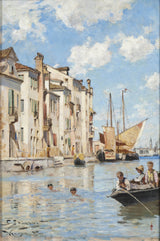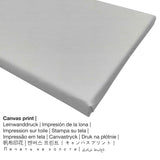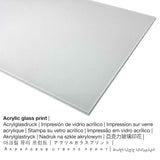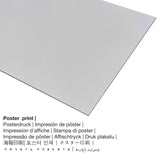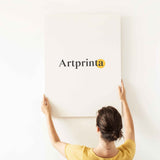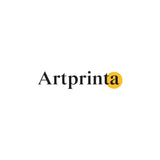Carl Skånberg, 1882 - Ụmụaka na-asa ahụ - ọmarịcha nka
Ụtụ gụnyere. Mbupu gbakọrọ na ndenye ọpụpụ.
Ozi ndabere gbasara ọrụ nka pụrụ iche
| Aha eserese: | "Children Bathing" |
| Nhazi nka: | sere |
| Okwu mkpokọta: | nkà nke oge a |
| oge: | 19th narị afọ |
| Year: | 1882 |
| Afọ nka: | karịa afọ 130 |
| Usoro nka izizi: | mmanụ na kwaaji |
| Nha nke ihe osise izizi: | Ogologo: 36 cm (14,1 ″); Obosara: 25 cm (9,8 ″) Ekebere: Elu: 50 cm (19,6 ″); Obosara: 38,5 cm (15,1 ″); Omimi: 5 cm (1,9 ″) |
| Egosiputara na: | National Museum nke Stockholm |
| Ebe ebe ngosi nka: | Stockholm, Obodo Stockholm, Sweden |
| weebụsaịtị nke Museum: | National Museum nke Stockholm |
| Ụdị nka nka: | ngalaba ọha |
| Site n'aka: | Nationalmuseum Stockholm na Wikimedia Commons |
Tebụl nchịkọta ihe nkiri
| aha: | Carl Skånberg |
| Nationality: | Swedish |
| Ọrụ nke onye na-ese ihe: | onye na-ese ihe |
| Mba onye si: | Sweden |
| Nhazi nke onye nka: | omenkà nke oge a |
| Afọ ọnwụ: | 33 afọ |
| Afọ ọmụmụ: | 1850 |
| Amụrụ na (ebe): | Norrköping |
| Afọ ọnwụ: | 1883 |
| Nwuru na (ebe): | Stockholm |
Banyere edemede a
| Bipụta ụdị ngwaahịa: | nka nka |
| Usoro mmeputakwa: | dijitalụ mmeputakwa |
| Produzọ mmepụta: | Mbipụta UV ozugbo (mbipụta dijitalụ) |
| Ihe ngosi: | emepụtara na Germany |
| Stockdị ngwaahịa: | na mmepụta ihe |
| Ojiji ngwaahịa: | ịchọ mma mgbidi, ihe ndozi mgbidi |
| Ndozi onyonyo a: | nhazi ihe osise |
| Oke akụkụ onyonyo: | (ogologo: obosara) 2: 3 |
| Mmetụta nke akụkụ akụkụ: | ogologo bụ 33% mkpụmkpụ karịa obosara |
| Nhọrọ dị: | Mpempe akwụkwọ, akwụkwọ mmado (akwụkwọ akpa), mbipụta enyo acrylic (nwere ezigbo mkpuchi iko), mbipụta ọla (aluminium dibbond) |
| Nhọrọ nke Canvas Mbipụta (akwa akwa na etiti ihe ndọtị): | 20x30cm - 8x12", 40x60cm - 16x24", 60x90cm - 24x35", 80x120cm - 31x47", 100x150cm - 39x59" |
| Mpempe iko acrylic (nwere ezigbo mkpuchi iko) nha dị iche iche: | 20x30cm - 8x12", 40x60cm - 16x24", 60x90cm - 24x35", 80x120cm - 31x47", 100x150cm - 39x59" |
| Nhọrọ nha nke akwụkwọ mmado (akwụkwọ kwaaji): | 40x60cm - 16x24", 60x90cm - 24x35", 80x120cm - 31x47" |
| Nhọrọ Dibond (ihe alumnium) nhọrọ: | 20x30cm - 8x12", 40x60cm - 16x24", 60x90cm - 24x35", 80x120cm - 31x47" |
| Nhazi nke nnomi nka: | enweghị etiti |
Họrọ ngwa ngwaahịa ịchọrọ idowe n'ụlọ gị
Anyị na-enye ihe dị iche iche dị iche iche na nha maka ngwaahịa ọ bụla. Ị nwere ike ịhọrọ n'ime nhọrọ nhazi ngwaahịa ndị a:
- Glass acrylic e biri ebi (nwere ezigbo mkpuchi iko): The print on acrylic glass, which is often described as a print on plexiglass, changes the original work of art into beautiful wall décor and forms a viable alternative to canvas and dibond fine art prints. With an acrylic glass art print sharp contrasts and smaller painting details will be more visible with the help of the delicate tonal gradation. Our plexiglass with real glass coating protects your selected art print against sunlight and external influences for many years.
- Aluminom dibond mbipụta (ọla): Aluminium Dibond prints are metal prints with a true depth. Its non-reflective surface structure make a modern look. Colors are luminous and bright in the highest definition, the details appear very clear, and you can feel the matte appearance of the product.
- Mbipụta akwụkwọ mmado (akwa akwa akwa): The poster is a UV printed canvas with a slightly rough surface finish. A poster print is suited for framing the art print with the help of a customized frame. Please bear in mind, that depending on the absolute size of the canvas poster print we add a white margin of approximately 2 - 6cm round about the print motif, which facilitates the framing.
- Mbipụta kanvas: A printed canvas mounted on a wooden stretcher frame. It generates the sculptural effect of three-dimensionality. The advantage of canvas prints is that they are relatively low in weight, meaning that it is easy and straightforward to hang up the Canvas print without additional wall-mounts. A canvas print is suitable for all types of walls.
Nchịkọta ngwaahịa
The 19th narị afọ artwork was created by Carl Skånberg in 1882. The 130 year old version of the artpiece has the size: Ogologo: 36 cm (14,1 ″); Obosara: 25 cm (9,8 ″) Ekebere: Elu: 50 cm (19,6 ″); Obosara: 38,5 cm (15,1 ″); Omimi: 5 cm (1,9 ″) and was painted with the techinque of oil on canvas. Today, this artwork is included in the collection of Nationalmuseum Stockholm. With courtesy of Nationalmuseum Stockholm na Wikimedia Commons (licensed - public domain).: . Furthermore, alignment of the digital reproduction is in Eserese usoro ma nwee oke nke 2: 3, nke pụtara na ogologo bụ 33% mkpụmkpụ karịa obosara.
Ihe dị mkpa: We try the best we can to describe our products as precisely as possible and to exhibit them visually in our shop. Please keep in mind that the colors of the printing material, as well as the print result might differ to a certain extent from the presentation on the device's monitor. Depending on the screen settings and the nature of the surface, color pigments might not be printed 100% realistically. Considering that all art reproductions are processed and printed by hand, there may as well be minor discrepancies in the size and exact position of the motif.
© Nwebiisinka nke - www.artprinta.com (Artprinta)

